 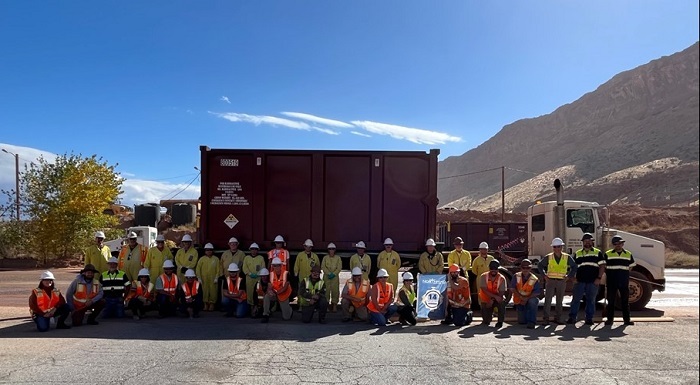 Team members with EM's Moab Uranium Mill Tailings Remedial Action Project pose by a haul truck carrying the final container of mill tailings to reach 14 million tons of the material for disposal.
MOAB, Utah – Crews achieved an EM 2023 priority at the Moab Uranium Mill Tailings Remedial Action (UMTRA) Project last week by successfully relocating another 1 million tons of uranium mill tailings away from the Colorado River, bringing the cumulative total to 14 million tons permanently disposed.
The mill tailings were shipped by rail from Moab, Utah, to an engineered disposal facility in Crescent Junction, Utah. Removing and shipping the mill tailings from Moab is a priority for EM’s cleanup this year and its 10-year Strategic Vision.
“Every year the Moab UMTRA team works through numerous challenges to advance EM’s cleanup and closure mission at Moab. This year is no different,” Acting Federal Cleanup Director Matthew Udovitsch said. “Reaching 14 million tons put us another step closer to executing EM’s mission at Moab.”
 Expressing pride, Udovitsch thanked the Moab Project’s dedicated team, the Moab community, agency partners and project stakeholders for helping EM reach the milestone ahead of schedule.
“It is exciting to see years of community and project work get so close to completion,” he said.
The Moab Project, which began moving mill tailings in 2009, is charged with shipping an estimated 16 million tons of the contaminated soil and debris to an engineered disposal cell in Crescent Junction, 30 miles north of the Moab site. The material resulted from legacy uranium milling operations.
As the Moab Project nears completion, local, state and federal stakeholders are planning for the site’s future after remediation is complete.
-Contributor: Barbara Michel
 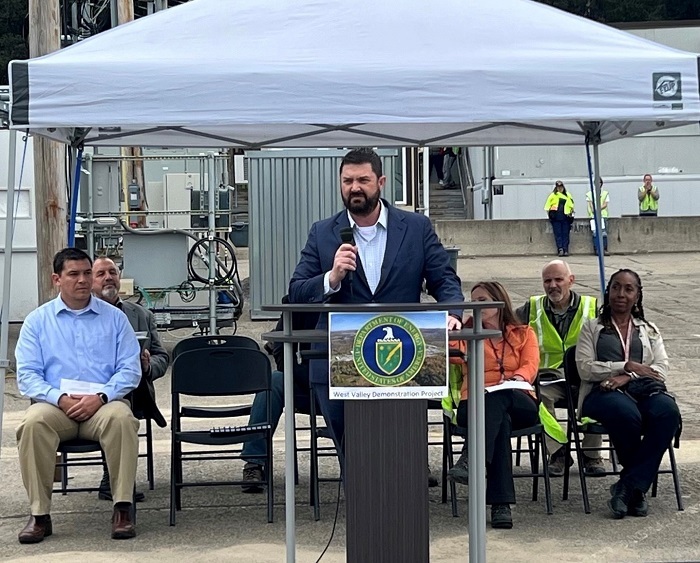 EM Principal Deputy Assistant Secretary Jeff Avery congratulates employees at the West Valley Demonstration Project for their safety record, accomplishments and ongoing work to tear down the Main Plant Process Building. West Valley crews accomplished an EM 2023 priority after safely shipping more than 9,000 tons of debris from the demolition project.
WEST VALLEY, N.Y. – EM Principal Deputy Assistant Secretary Jeff Avery visited the West Valley Demonstration Project last week to observe cleanup progress and meet with employees and key community stakeholders.
A highlight of his trip was an event to celebrate West Valley prime contractor CH2M HILL BWXT West Valley (CHBWV) recently receiving the DOE Voluntary Protection Program’s (VPP) Star of Excellence.
“The primary importance in West Valley’s cleanup mission is the men and women in the field who implement the work plans and deliver projects to completion in a safe and compliant manner that meets or exceeds regulations and requirements,” Avery said during an address to the West Valley workforce. “This can only be achieved because of the tremendous and constant focus on keeping each other safe.”
EM West Valley Director Bryan Bower said the site was honored to host Avery.
“It’s important to see the work up close that’s being accomplished at the site, and how this work fits into DOE’s mission and cleanup strategy,” Bower said.
 DOE officials gather for a photo in front of the Main Plant Process Building demolition project during a tour of cleanup efforts at EM’s West Valley Demonstration Project. From left are Kristen Ellis, EM acting associate principal deputy assistant secretary for EM's Office of Regulatory and Policy Affairs; Stephen Bousquet, assistant director of the West Valley Office of Project Management, Jeff Avery, EM principal deputy assistant secretary; Patrick Hefflinger, EM legislative affairs specialist; Melody Bell, EM Consolidated Business Center director director; Cathy Tullis, EM chief of staff; Jennifer Dundas, assistant director of the West Valley Office of Technical Services; and Alfred Traylor, director of the DOE Office of Worker Safety and Health Assistance.
Avery talked with the employees about their careers and future with the cleanup program, and met with representatives from New York State Energy Research and Development Authority (NYSERDA). EM and CHBWV conduct the West Valley cleanup in cooperation with NYSERDA.
He also gathered with members of the West Valley Citizen Task Force, comprised of western New York residents who provide recommendations regarding completion of the West Valley cleanup, and closure or long-term management of the site.
Recipients of the Star of Excellence award have achieved an outstanding level of performance in meeting established safety and health goals, actively conducting outreach to others and achieving an injury and illness rate significantly below the average of similar businesses and operations.
“Without you, there would be no cleanup or risk reduction for our communities and the environment. This accomplishment speaks volumes of your abilities to find solutions and use lessons learned to solve some of the most challenging problems we face in reducing legacy risks,” Avery said. “This team has proven that difficult, high hazard work can be completed safely. That is no surprise considering this same workforce was one of the first in the DOE-EM complex to achieve VPP Star of Excellence status, an award bestowed upon the safest of the safe DOE sites.”
Jennifer Dundas, assistant director of the EM West Valley Office of Technical Services, also thanked the CHBWV employees for their efforts.
“All of you should be proud of this accomplishment and recognition,” Dundas said. “This team has demonstrated that safety is paramount at West Valley. Your involvement and proactive approach to safety promotes a safety culture that is continuously improving the work environment and reducing risks.”
Dundas introduced Alfred Traylor, director of the DOE Office of Worker Safety and Health Assistance, who presented West Valley employees with the Star of Excellence plaque for exceeding minimum safety rates and having an overall robust safety program. The site also was recertified as a VPP site.
“I had a tour of the site this morning, and I was quite impressed with the ongoing cleanup efforts, as well as your safety record. This only happens when commitment starts in the field where the work is being done,” Taylor said. “The safety and health of our employees, both contractor and federal, are the highest priorities for the Department. DOE’s Voluntary Protection Program promotes safety and health excellence through cooperative efforts among labor, management and government at the DOE contractor sites.”
-Contributor: Joseph Pillittere

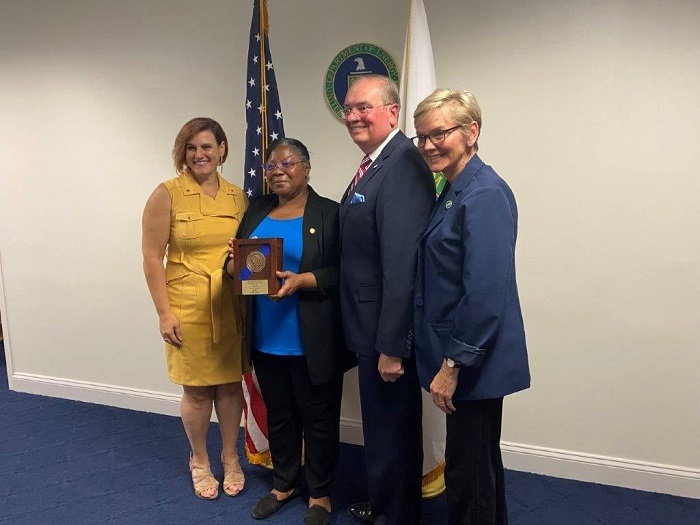 Jessie Hill Roberson holds the Secretary of Energy Distinguished Service Award presented by Energy Secretary Jennifer Granholm, far right. Also pictured are Joyce Connery, Defense Nuclear Facilities Safety Board chair, and Thomas Summers, the board's vice chairman.
A former EM assistant secretary who recently retired from the Defense Nuclear Facilities Safety Board (DNFSB) was honored by Energy Secretary Jennifer Granholm with an award for distinguished service for her dedicated service to the Department and nation.
Granholm recognized Jessie Hill Roberson with the Secretary of Energy Distinguished Service Award for the culmination of an extraordinary career. Roberson’s leadership and contributions to EM and the DNFSB have significantly impacted the success of the DOE mission, according to the award citation.
Roberson was nominated by former President George W. Bush to lead EM in 2001. She served in that capacity for three years. Read a 2013 EM Update interview in which Roberson reflects on her experience as EM assistant secretary.
 |
|
Jessie Hill Roberson served as the fifth Senate-confirmed assistant secretary for EM from July 2001 to July 2004. |
In 1994, Roberson became the assistant manager for the environmental restoration programs, managing two divisions intimately involved in the cleanup of the former Rocky Flats Plant. In 1996, she was selected as the Rocky Flats Field Office manager due to her superior performance overseeing the spectrum of environmental restoration activities at the site near Denver, Colorado. During her tenure, a clear path to closure was identified with significant schedule compression and cost savings, and a full-scale decontamination and decommissioning began under her leadership. Roberson also had worked as an engineer at the Savannah River Site in Aiken, South Carolina, in environmental cleanup, waste management, safeguards and security, as well as nuclear reactors and weapons.
In 2000, Roberson was selected as a board member for the DNFSB, responsible for monitoring DOE’s nuclear defense-related activities. In 2001, as EM assistant secretary, Roberson sought to apply lessons learned from Rocky Flats to other cleanup sites. Her goal was always to inspire innovation to achieve safe and effective cleanup of EM sites.
In 2004, Roberson left DOE for the private industry, and in 2010, she was requested to serve on the DNFSB, as vice chairperson.
A native of Evergreen, Alabama, Roberson has over 30 years of experience in the nuclear engineering field, with profound experience in low-level waste management, environmental restoration, reactor operations and project management.
Before joining DOE, Roberson worked with Georgia Power Company as a system engineering specialist from 1987 to 1989. At Georgia Power, Roberson focused on maintenance, testing, upgrades and performance reliability of electrical and mechanical plant systems and equipment.
She has extensive experience in nuclear reactor operations and successfully completed the testing requirements for reactor operations with E. I. DuPont in 1982. Later with DuPont she trained nuclear reactor operators and supervisors in both nuclear and field operations. Before leaving DuPont in 1987 Roberson worked as a nuclear reactor operations manager at several sites.
From 1977 to 1980, Roberson completed work assignments as a student engineer for Westinghouse at the Clinch River Breeder Reactor in Oak Ridge, Tennessee, and the Nuclear Center in Monroeville, Pennsylvania. Roberson received a Bachelor of Science degree in nuclear engineering from the University of Tennessee in Knoxville, Tennessee.
-Contributor: David Sheeley
 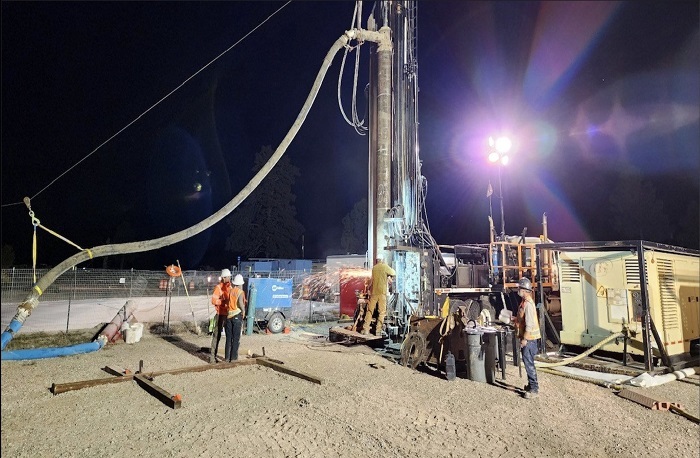 EM crews drill a well for hexavalent chromium plume characterization and monitoring to meet a New Mexico Environment Department Consent Order Appendix B Fiscal Year milestone.
LOS ALAMOS, N.M. – The EM Los Alamos Field Office (EM-LA) successfully completed several key legacy cleanup accomplishments in the fiscal year ending Sept. 30, including meeting all regulatory milestones, exceeding transuranic (TRU) waste shipment goals and wrapping up field work for a priority cleanup project.
“The fiscal year 2023 achievements tell the story of real progress,” EM-LA Manager Michael Mikolanis said. “We have much more work to do, but we’re on a positive path here in Los Alamos, which sets the stage for an even more productive fiscal year 2024.”
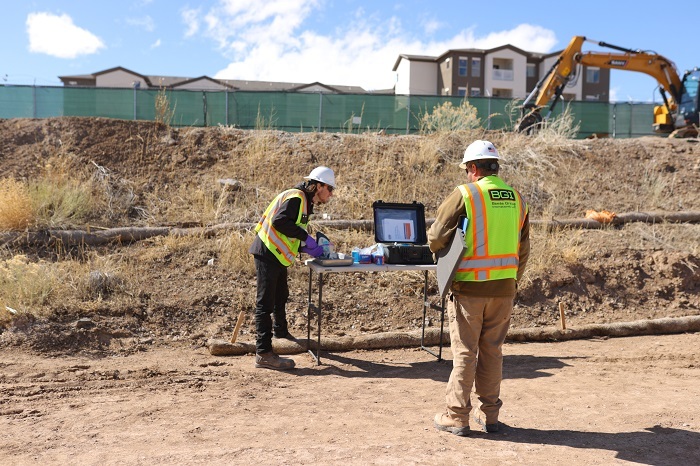 Sampling activity at Middle DP Road Site prior to field work completion.
EM-LA and Newport News Nuclear BWXT Los Alamos (N3B), the legacy cleanup contractor at Los Alamos National Laboratory (LANL), met all 14 of the Fiscal Year 2023 (FY23) Appendix B regulatory milestones agreed to with the New Mexico Environment Department through the 2016 Compliance Order on Consent that guides cleanup activities at LANL.
The milestones relate to hexavalent chromium plume characterization; Material Disposal Area investigation plans and a submitted preferred alternative for remediation; investigations of aggregate areas, which are canyons and drainage areas throughout LANL; and other ongoing initiatives to protect water quality and remediate contaminated soil.
 EM crews prepare to cut a 20-foot-long corrugated metal pipe containing cemented transuranic waste into five pieces to be loaded into standard waste boxes for characterization, shipment and ultimate disposal at the Waste Isolation Pilot Plant.
Additional FY23 cleanup highlights include:
- Completing 59 shipments of TRU waste to the Waste Isolation Pilot Plant (WIPP) for disposal, beating an EM FY23 goal of 40 shipments.
- Disposing of more than 4,300 cubic meters of TRU, mixed and low-level radioactive, hazardous and other waste.
- Completing work at two aggregate areas: North Ancho Canyon and Threemile Canyon.
- Conducting retrieval and initiating size-reduction activities for a set of buried corrugated metal pipes containing TRU waste to prepare them for shipment and disposal at WIPP.
- Completing field work at the Middle DP Road Site, a project critical to economic development for Los Alamos County.
- Treating nearly 42 million gallons of hexavalent chromium-contaminated groundwater.
“I’m proud of the hard work and dedication of the Los Alamos legacy cleanup workforce in achieving our accomplishments for FY23,” said N3B President and General Manager Brad Smith. “We’re establishing a strong foundation of safe performance. We’re excited to begin FY24 more focused than ever on maintaining a safety conscious work environment and staying on a path of continuous improvement.”
-Contributor: Brian Leugs
 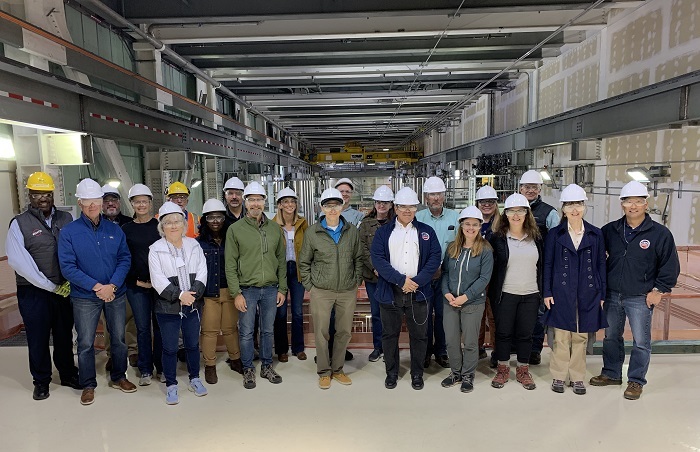 Cleanup Dialogue meeting attendees tour the Hanford Site Waste Treatment and Immobilization Plant.
PASCO, Wash. – Officials with EM headquarters and field sites across the DOE complex met with an array of state and federal stakeholders recently for the sixth Cleanup Dialogue meeting.
Their discussions centered on environmental justice, EM land transfers for reuse, opportunities for alternative energy at the cleanup sites, and per- and polyfluoroalkyl substances (PFAS), an emerging contaminant migrating into the environment from chemicals used in all types of materials.
A member of the Nez Perce Tribe gave a keynote address, and meeting participants toured the Hanford Site — home to the world’s first plutonium production reactor — and DOE’s Pacific Northwest National Laboratory.
Representatives from the U.S. Environmental Protection Agency (EPA) and the Environmental Council of the States (ECOS) Federal Facilities Forum took part in the meeting. Officials from the forum’s member states of Tennessee, Washington, New Mexico, South Carolina, Nevada, Ohio and Utah participated, along with EPA’s Office of Land and Emergency Management and Federal Facilities Restoration and Reuse Office.
Through a partnership with EM, ECOS facilitates ongoing working relationships with senior-level federal leaders involved in the cleanup of the nuclear weapons complex.
-Contributor: Demitrous Blount
  Officials with the National Nuclear Security Administration and Consolidated Nuclear Security, the Y-12 National Security Complex management and operations contractor, break ground for the new Lithium Processing Facility.
OAK RIDGE, Tenn. – EM’s steady work removing old, contaminated structures at Oak Ridge is paving the way for new uses of land, including a site where the National Nuclear Security Administration (NNSA) recently hosted a groundbreaking ceremony for its new Lithium Processing Facility.
The Oak Ridge Office of Environmental Management (OREM) and contractor UCOR finished a project late last year that opened the 18-acre area at the Y-12 National Security Complex (Y-12) for the NNSA facility. OREM crews had cleared away the former Biology Complex comprised of 11 structures dating back to the 1940’s.
This success story in reuse of land once used for the Manhattan Project and Cold War demonstrates that OREM and UCOR are achieving more than risk reduction through their cleanup at Y-12 and Oak Ridge National Laboratory: They’re opening space to support important missions.
The groundbreaking held by NNSA and Consolidated Nuclear Security (CNS), the Y-12 management and operations contractor, marked the beginning of site preparation for the construction project.
“Y-12’s lithium processing capabilities are significant to the Department of Energy and National Nuclear Security Administration,” NNSA Principal Deputy Administrator Frank Rose said. “Both lithium processing and uranium processing are crucial to maintaining our nuclear weapons stockpile.”
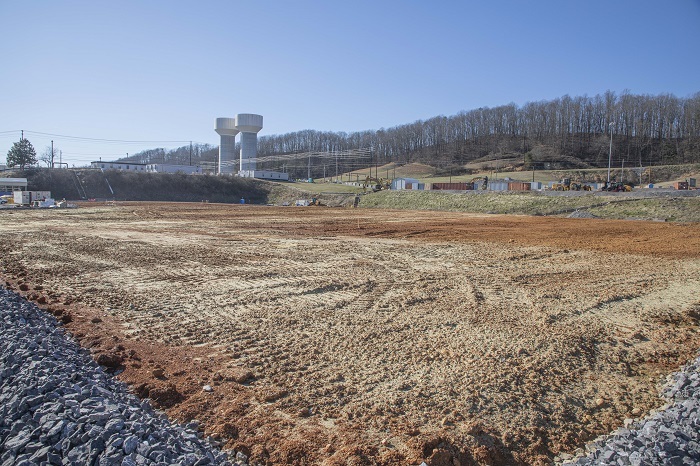 The Oak Ridge Office of Environmental Management finished removing the former Biology Complex and transferred the land it sat on back to the National Nuclear Security Administration in 2022. The EM project cleared 18 acres of land for the Y-12 National Security Complex to construct its new Lithium Processing Facility.
The new 245,000-square-foot facility will feature updated technology, increase processing capacity and make the work environment safer for employees. Construction is forecasted to begin in mid 2025, with completion projected in the early 2030s.
Y-12 is a supplier of lithium materials to support U.S. defense missions, and it’s the only DOE and NNSA facility with lithium processing and production capabilities.
“The Lithium Processing Facility is one of several transformational projects that are in progress or have been completed here on site,” said Y 12 Site Manager Gene Sievers. “Everywhere you look, our site is transforming for the future.”
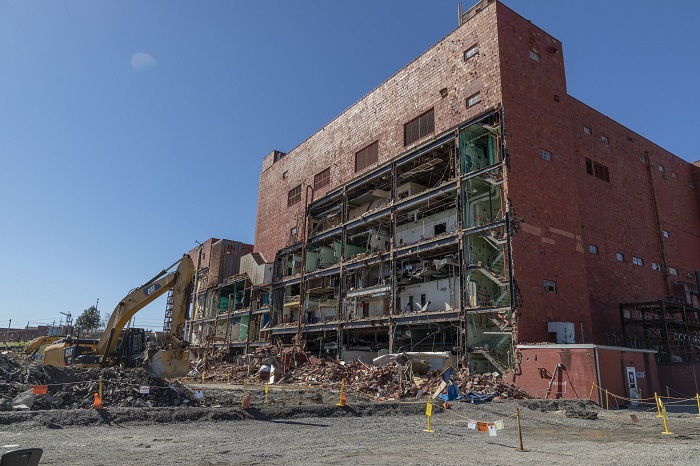 Building 9207 was the last of 11 buildings the Oak Ridge Office of Environmental Management demolished last year as part of the former Biology Complex demolition project. It stood six stories tall and spanned 255,000 square feet.
Today, nearly 60% percent of NNSA’s facilities are more than 40 years old, with many dating to the Manhattan Project. OREM and UCOR are changing that with numerous projects already underway to continue the transformation and enable modernization at Y-12.
OREM is preparing two large Manhattan Project-era enrichment buildings for near-term demolition at Y-12.
Crews are scheduled to begin demolition on the Alpha-2 facility next year, and they are also making progress deactivating the nearby Beta-1 facility.
“Our mission is especially rewarding when you can see a direct connection between our progress and new growth and opportunities at the site,” said OREM Manager Jay Mullis. “We’re focused on maintaining that momentum to enable and support Y-12’s important ongoing missions.”
-Contributor: Ben Williams
 
EM recently announced the launch of its LinkedIn social media platform. Follow the cleanup program to get information on job announcements, news on cleanup progress, employee spotlights and much more.
LinkedIn is more than just a job search engine — it’s a place where everyone can engage in content, connect with colleagues and grow a professional network.
 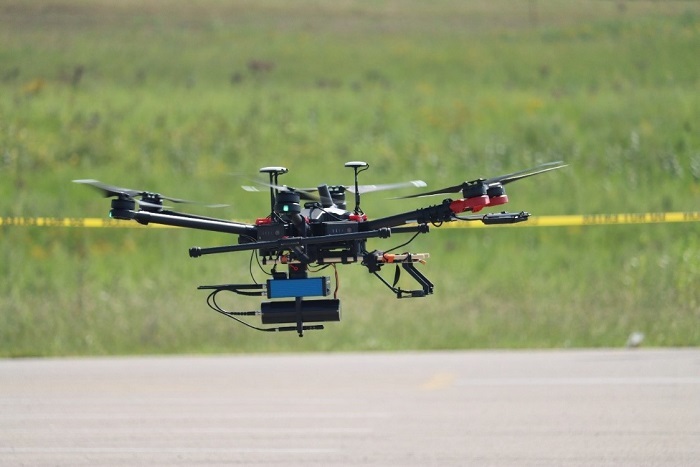 The Portsmouth Site provides a safe and effective location for the Ohio Department of Health to test its radiation detection drone.
PIKE COUNTY, Ohio – A drone outfitted with radiation detectors recently underwent testing at the Portsmouth Site for potential future use as part of growing collaboration between EM and the state of Ohio.
“The Portsmouth Site has the radioactive source materials while the Ohio Department of Health (ODH) has the drones,” Portsmouth/Paducah Project Office Nuclear Safety Oversight Lead Tom Hines said of the partnership. “We’re hoping to follow ODH’s lead and incorporate this into the DOE Emergency Management Program. The potential to use a drone to detect chemicals following an accidental release would be a highly valuable asset for the DOE response capability.”
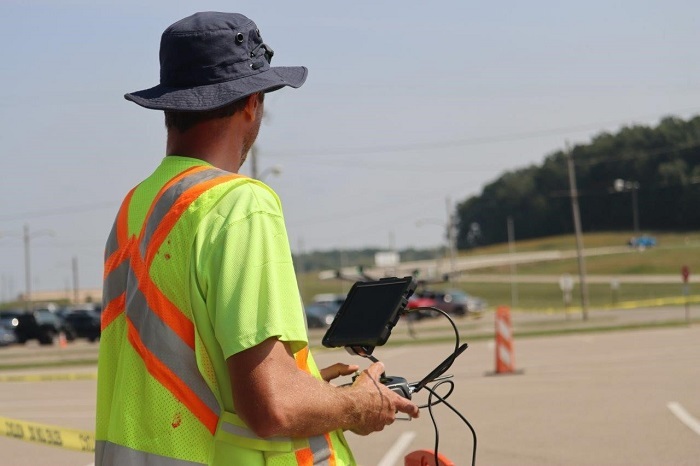 Ohio Department of Transportation Unmanned Aircraft System Data Manager Jamie Davis operates a drone at the Portsmouth Site in a test effort to collect data for potential future use by the state of Ohio and EM.
The successful drone testing collected data for ODH to further develop its procedures and policies. The Ohio Department of Transportation supported the testing.
EM will also evaluate the data to determine if the technology is beneficial for use at its cleanup sites. The drone has video and photographic capabilities, and can connect wirelessly to a laptop. Data can also be shared through a smartphone app.
“This event allowed ODH to utilize radioactive source material they would not normally have access to,” said Rob Litten, source control coordinator for Fluor-BWXT Portsmouth (FBP), EM's decontamination and decommissioning contractor for the Portsmouth Site. “This increased the scope of their testing and confirmed the detection capabilities of the drones and detection equipment.”
ODH was pleased with the cooperation and flexibility of everyone involved with the testing, said Kevin Banks, nondestructive assay oversight with Enterprise Technical Assistance Services, the Portsmouth Site’s technical support contractor.
“ODH’s initial goal was to be able to create an exclusion zone with their technology in the event an accident containing radioactive material occurred,” Banks said. “Prior to today’s event, they had not been able to test the capabilities of their equipment due to their limited radioactive source access.”
Personnel would be prohibited from entering an exclusion zone due to an accident involving radioactive material.
-Contributor: Michelle Teeters
  Workers transfer customized asphalt from a delivery truck to construct a surface barrier above U Tank Farm on the Hanford Site.
RICHLAND, Wash. – Crews with the EM Office of River Protection (ORP) at the Hanford Site have completed construction of a 144,100-square-foot interim surface barrier over a group of underground waste-storage tanks.
“Interim surface barriers are one critical part of reducing risks to groundwater under our storage tanks for radioactive and chemical waste,” said Becky Blackwell, EM program manager for the Tank Farms Programs Division. “The barriers prevent surface water from getting into soil above the tanks and driving contamination in the soil deeper toward the groundwater.”
An impermeable asphalt barrier at Hanford’s U Tank Farm is sloped, diverting rain and snowmelt to a lined basin, where it evaporates.
Surface barriers are temporary structures constructed under terms of the Tri-Party Agreement and will remain in place until a final farm closure plan is determined.
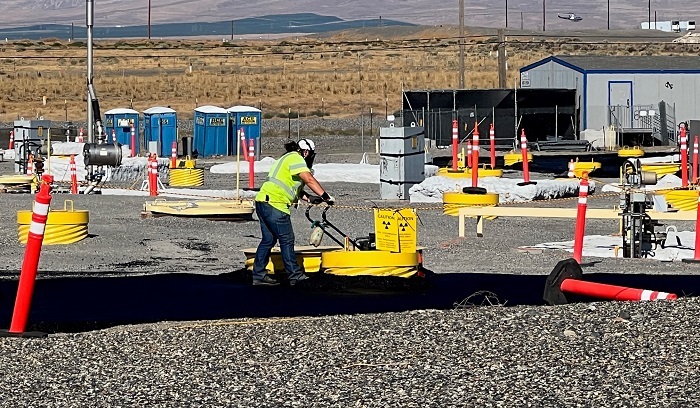 Crews operate compactors to level and compress surface barrier asphalt in tight areas around infrastructure at the U Tank Farm on the Hanford Site.
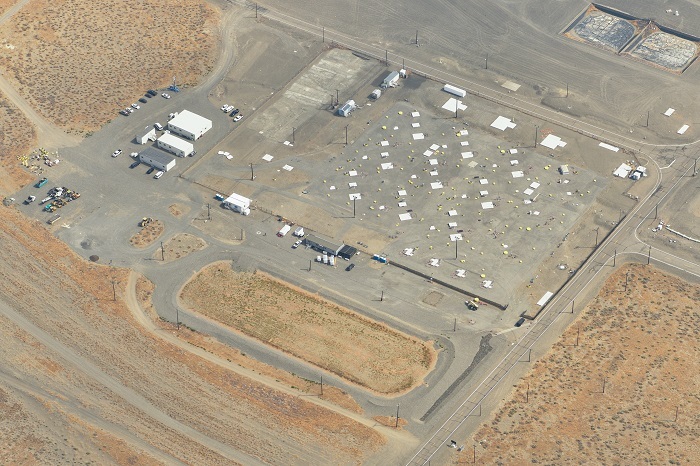 An aerial of the Hanford Site’s U Tank Farm and its runoff basin before workers installed the surface barrier.
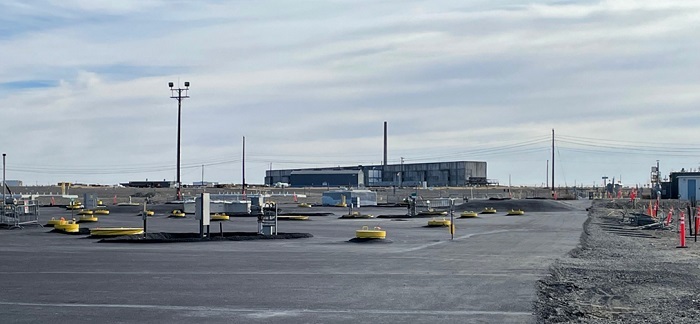 A new interim surface barrier recently installed over the Hanford Site’s U Tank Farm.
Workers started paving the barrier in August, but preliminary work on the project started more than two years ago when Hanford Site tank operations contractor Washington River Protection Solutions (WRPS) designed the barrier and its companion evapotranspiration basin.
“These projects are engineering intensive,” said Ruben Mendoza, WRPS deputy manager of Production Operations Engineering. “We analyze soil samples to identify areas of possible contamination and establish the size of the barrier to cover those areas, while also ensuring the construction process.”
Specialized asphalt is required for this kind of work, and it has to be trucked to the tank farm from off-site.
“This is much more complicated than a road paving project,” said Tom Sackett, WRPS manager of Tank Farm Projects. “The proprietary asphalt mixture is stickier than standard asphalt and there are logistical challenges because the asphalt has to be mixed away from the site. However, our subcontractors, as well as the asphalt supplier, all worked well together, allowing us to complete the fieldwork a few days ahead of schedule.”
Workers used motorized equipment to level and compress the asphalt in open areas, and hand-operated equipment in tighter spots around tank farm infrastructure. In all, approximately 3,765 tons of asphalt were used to construct the interim surface barrier at U Farm, marking the fifth Hanford tank farm to have a barrier installed.
The next interim surface barrier projects are already on the schedule. Crews will remove a demonstration barrier at T Tank Farm, installed in 2008, and replace it with an asphalt barrier. The first step for the removal and replacement project will be design work scheduled to begin in 2024. Then teams will construct an asphalt barrier over the B Tank Farm.
-Contributor: Jenna Kochenauer
  As champions of Cybersecurity Awareness Month, presented by the National Cybersecurity Alliance, Savannah River Mission Completion’s cybersecurity and information technology team is committed to cybersecurity protection and best practices.
AIKEN, S.C. – For the second consecutive year, EM’s liquid waste contractor at the Savannah River Site (SRS) has been named a champion of cybersecurity awareness for ensuring its people and programs stay safe online.
As a 2023 National Cybersecurity Alliance (NCA) Cybersecurity Awareness Month Champion, Savannah River Mission Completion (SRMC) is committed to cybersecurity protection and best practices. SRMC has been the liquid waste contractor for EM at SRS since February 2022.
Cybersecurity is a critical component of DOE missions, according to Lewann Belton, DOE-Savannah River Cyber and Information Technology Division manager.
“Robust operation and protection of our information systems is essential to EM’s mission, and I appreciate the support that the site’s contractors provide for our cybersecurity programs,” Belton said. “Savannah River Mission Completion earning the champion status for national Cybersecurity Awareness Month is a great example of commitment to good cyber health.”
Held every October, Cybersecurity Awareness Month is a collaboration between the government and private industry to empower everyone to protect their personal data from digital forms of crime. This year marks the 20th year of the annual recognition. Presented by the U.S. Department of Homeland Security’s Cybersecurity and Infrastructure Security Agency and the NCA, the program’s theme is “Secure Our World.” Cybersecurity Awareness Month champions are companies dedicated to promoting a safer, more secure and more trusted Internet, as designated by the NCA.
As SRMC’s chief information officer, Mirwaise Aurah oversees all process applications and business, cyber and information technology (IT) systems. He is leading the strategic effort to provide enhanced and more focused IT services within SRMC.
“Cybersecurity may seem like a complex subject, but it’s really all about people,” Aurah said. “Demonstrating good practices while operating online, while at work or home, is a strategy that everyone can and should follow. SRMC is committed to safeguarding our information systems to ensure the efficiency and integrity of our mission.”
Best cybersecurity practices promoted by the NCA and demonstrated by SRMC include using strong passwords and multifactor authentication, recognizing and reporting phishing and updating software.
-Contributor: Colleen Hart
|



